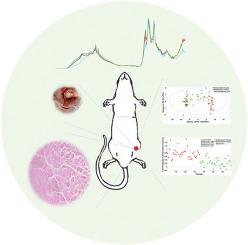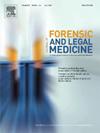A continuous forensic spectral analysis study to identify antemortem and postmortem muscle contusions by chemometrics
IF 1.2
4区 医学
Q3 MEDICINE, LEGAL
引用次数: 0
Abstract
The differentiation between antemortem and postmortem mechanical injuries constitutes a critical challenge in forensic pathology, particularly given the scarcity of reliable diagnostic markers for severely autolyzed or decomposed cadavers. This study pioneers an integrative methodology combining advanced morphological characterization, infrared spectroscopy, and chemometric modeling to identify molecular signatures distinguishing antemortem from postmortem trauma. The spectral analysis revealed distinct biomarker patterns associated with proteins (1643 cm−1 and 1560 cm−1), phospholipids (1402 cm−1), and carbohydrate complexes (1011 cm−1). These molecular fingerprints demonstrate significant discriminative potential in trauma vitality assessment. Through systematic pattern recognition, we developed optimized partial least squares-discriminant analysis (PLS-DA) models achieving superior classification accuracy in both cross-validation and external validation cohorts. The established protocol demonstrates three critical advantages: enhanced diagnostic reliability in advanced decomposition states, quantitative spectral interpretation through chemometric processing, and methodological standardization for prolonged postmortem intervals. This multimodal approach addresses a persistent forensic limitation, offering a scientifically robust framework for trauma vitality determination in challenging postmortem contexts. In the future, by further simplifying the complexity of the method and integrating forensic examination comprehensive analysis, this method has promising applications in forensic investigations requiring vitality assessment with differentiation of antemortem from postmortem injury, including after extended postmortem intervals.

一项持续的法医光谱分析研究,通过化学计量学来识别死前和死后的肌肉挫伤
区分死前和死后的机械损伤是法医病理学的一个关键挑战,特别是考虑到对严重自溶或腐烂的尸体缺乏可靠的诊断标记。这项研究开创了一种综合方法,结合了先进的形态学表征、红外光谱和化学计量学模型,以识别区分死前和死后创伤的分子特征。光谱分析揭示了与蛋白质(1643 cm−1和1560 cm−1)、磷脂(1402 cm−1)和碳水化合物复合物(1011 cm−1)相关的不同生物标志物模式。这些分子指纹在创伤活力评估中显示出显著的鉴别潜力。通过系统的模式识别,我们开发了优化的偏最小二乘判别分析(PLS-DA)模型,在交叉验证和外部验证队列中都获得了更高的分类精度。建立的方案显示了三个关键优势:在高级分解状态下提高诊断可靠性,通过化学计量处理进行定量光谱解释,以及延长尸检间隔的方法标准化。这种多模式的方法解决了一个持续的法医限制,为在具有挑战性的死后环境中确定创伤活力提供了一个科学可靠的框架。未来,通过进一步简化方法的复杂性,结合法医检验综合分析,该方法在需要区分死前和死后损伤的活力评估的法医调查中,包括延长死后时间的法医调查中,具有广阔的应用前景。
本文章由计算机程序翻译,如有差异,请以英文原文为准。
求助全文
约1分钟内获得全文
求助全文
来源期刊

Journal of forensic and legal medicine
MEDICINE, LEGAL-
CiteScore
2.70
自引率
6.70%
发文量
106
审稿时长
57 days
期刊介绍:
The Journal of Forensic and Legal Medicine publishes topical articles on aspects of forensic and legal medicine. Specifically the Journal supports research that explores the medical principles of care and forensic assessment of individuals, whether adult or child, in contact with the judicial system. It is a fully peer-review hybrid journal with a broad international perspective.
The Journal accepts submissions of original research, review articles, and pertinent case studies, editorials, and commentaries in relevant areas of Forensic and Legal Medicine, Context of Practice, and Education and Training.
The Journal adheres to strict publication ethical guidelines, and actively supports a culture of inclusive and representative publication.
 求助内容:
求助内容: 应助结果提醒方式:
应助结果提醒方式:


